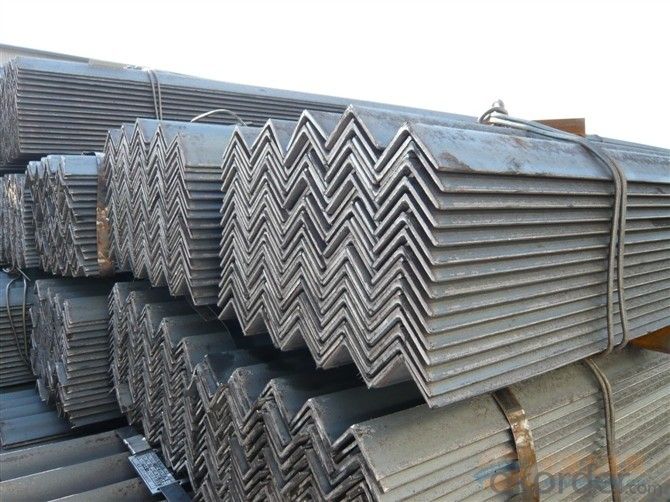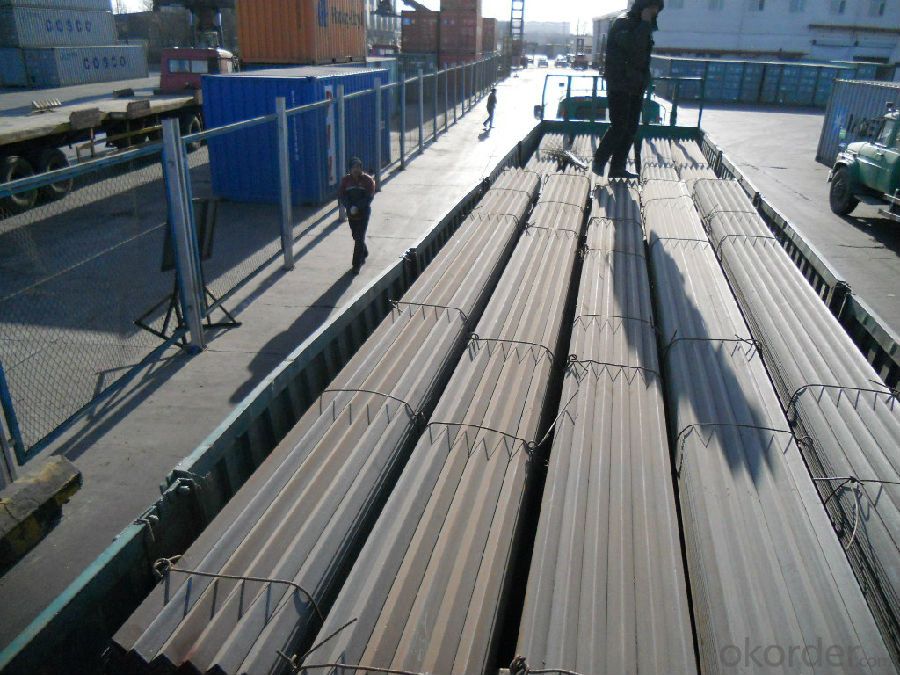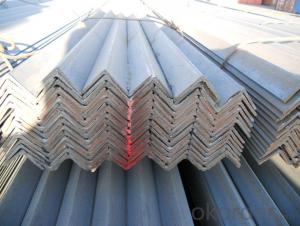Hot Rolled Steel Angle Bar with High Quality 90*90mm
- Loading Port:
- Tianjin
- Payment Terms:
- TT OR LC
- Min Order Qty:
- 25 m.t
- Supply Capability:
- 10000 m.t/month
OKorder Service Pledge
OKorder Financial Service
You Might Also Like
Product Description
Specifications of Equal Angle Steel
1.Standards:GB
2.Length:6m, 12m
3.Material:GBQ235 or Equivalent
4. Size:
Size (mm) | Mass (mm) | Size (mm) | Mass (mm) |
| 90*90*7 | 9.656 | 90*90*10 | 13.478 |
| 90*90*8 | 10.946 |
Usage & Applications of Equal Anlge Steel
Trusses;
Transmission towers;
Telecommunication towers;
Bracing for general structures;
Stiffeners in structural use.
Packaging & Delivery of Equal Angle Steel
1. Transportation: the goods are delivered by truck from mill to loading port, the maximum quantity can be loaded is around 40MTs by each truck. If the order quantity cannot reach the full truck loaded, the transportation cost per ton will be little higher than full load.
2. With bundles and load in 20 feet/40 feet container, or by bulk cargo, also we could do as customer's request.
3. Marks:
Color mark: There will be color marking on both end of the bundle for the cargo delivered by bulk vessel. That makes it easily to distinguish at the destination port.
Tag mark: There will be tag mark tied up on the bundles. The information usually including supplier logo and name, product name, made in China, shipping marks and other information request by the customer.
If loading by container the marking is not needed, but we will prepare it as customers' request.
FAQ:
Q1: Why buy Materials & Equipment from OKorder.com?
A1: All products offered byOKorder.com are carefully selected from China's most reliable manufacturing enterprises. Through its ISO certifications, OKorder.com adheres to the highest standards and a commitment to supply chain safety and customer satisfaction.
Q2: How do we guarantee the quality of our products?
A2: We have established an advanced quality management system which conducts strict quality tests at every step, from raw materials to the final product. At the same time, we provide extensive follow-up service assurances as required.
Q3: How soon can we receive the product after purchase?
A3: Within three days of placing an order, we will arrange production. The shipping date is dependent upon the quatity, how many sizes you want and the plan of production, but is typically 30 to 45 days from the beginning of production.
Images:


*If you would like to get our price, please inform us the size, standard/material and quantity. Thank you very much for your attention.
- Q:Can steel angles be used in the construction of hotels?
- Yes, steel angles can be used in the construction of hotels. Steel angles are commonly used in construction due to their durability, strength, and versatility. They can be used for a variety of purposes in hotel construction, such as supporting structural beams, reinforcing concrete slabs, framing walls, and creating architectural features. Steel angles provide stability and structural integrity, making them ideal for high-rise buildings like hotels. Additionally, steel angles are cost-effective and readily available, making them a practical choice for hotel construction projects.
- Q:How do steel angles resist bending or deflection?
- Steel angles resist bending or deflection due to their shape and material properties. The design of steel angles, with their L-shaped cross-section, provides structural stability and strength, making them highly resistant to bending or deflection under load. The L-shape of steel angles creates two perpendicular legs, which distribute the applied load more efficiently compared to other shapes. This distribution of load allows the angles to resist bending forces, preventing them from deforming or deflecting significantly. The longer leg of the angle provides greater leverage and stiffness, enhancing its resistance to bending. Moreover, steel itself is a strong and rigid material, known for its high tensile and compressive strength. Steel angles are typically made from hot-rolled steel, which undergoes a process that further improves its structural properties. The combination of the L-shape design and the inherent strength of steel enables steel angles to withstand bending forces without significant deflection. Additionally, steel angles can be reinforced through various methods such as welding or bolting to increase their resistance to bending or deflection. Reinforcements add additional strength and stiffness to the angles, making them even more robust and capable of withstanding higher loads. In summary, steel angles resist bending or deflection due to their L-shape design, the inherent strength of steel, and possible reinforcements. These factors work together to provide structural stability and prevent excessive deformation, making steel angles a reliable choice for various construction and engineering applications.
- Q:What are the different methods for painting steel angles?
- There are various approaches to painting steel angles, depending on the desired outcome and project conditions. Some commonly used methods include: 1. Applying with a brush: This traditional method involves using a paintbrush to directly apply paint onto the steel angle's surface. It offers greater control and precision, especially for smaller or intricate areas. 2. Utilizing spray application: Spray painting is favored for large-scale or industrial projects. It entails using a paint sprayer to evenly distribute paint onto the steel angle. This method is quicker and more efficient than brush application, resulting in a smooth, uniform finish. 3. Employing powder coating: This method involves applying a dry powder to the steel angle and then curing it under heat. The result is a durable and visually appealing finish. Powder coating is known for its resistance to chipping, scratching, and fading, making it ideal for outdoor applications or high-traffic areas. 4. Using electrostatic painting: Electrostatic painting employs an electric charge to attract paint particles to the steel angle. This technique ensures even coverage, reduces overspray, and yields a smooth and long-lasting finish. It is commonly used for large or complex surfaces due to its superior adhesion and coverage. 5. Opting for galvanizing: Galvanizing is a unique method used to protect steel angles from corrosion. It involves coating the steel angle with a layer of zinc through a hot-dip or electroplating process. Galvanized steel angles are highly durable and resistant to rust, making them suitable for outdoor or high-moisture environments. While galvanizing does not provide a specific color or aesthetic finish, the zinc coating can be painted over if desired. When selecting a painting method for steel angles, it is crucial to consider factors such as the desired appearance, durability, environmental conditions, and project specifications. Seeking guidance from a professional or adhering to the manufacturer's recommendations can help ensure the most suitable method is chosen for each unique project.
- Q:How do you reinforce a steel angle?
- There are several methods to reinforce a steel angle, depending on the specific application and requirements. Here are a few common techniques: 1. Welded Plates: One way to reinforce a steel angle is by adding welded plates at critical locations. These additional plates are typically made of the same or higher strength steel and are welded to the angle's flanges or web. This method increases the overall stiffness and load-bearing capacity of the angle. 2. Gusset Plates: Another effective method to reinforce a steel angle is by using gusset plates. These plates are typically triangular-shaped and are welded to the angle's flanges or web. Gusset plates distribute forces more evenly across the angle, increasing its strength and resistance to bending or torsion. 3. Bracing: Bracing is a technique used to reinforce a steel angle by adding additional steel members to it. These members can be either connected directly to the angle or attached using welded or bolted connections. Bracing effectively increases the angle's resistance to lateral or torsional forces and enhances its overall stability. 4. Composite Materials: In some cases, reinforcing a steel angle can be achieved by adding composite materials. Fiber-reinforced polymers (FRPs) or carbon fiber reinforced polymers (CFRPs) can be used to wrap or bond to the angle, providing additional strength and stiffness. These composite materials can significantly improve the angle's load-carrying capacity and resistance to corrosion. It is crucial to consult with a structural engineer or a professional with expertise in steel structures to determine the most suitable method for reinforcing a steel angle in a specific application. The chosen reinforcement technique must consider the expected loads, the angle's geometry, and the desired level of reinforcement.
- Q:What is the tensile strength of steel angles?
- The tensile strength of steel angles may vary depending on the grade of steel and the method of manufacturing employed. In general, steel angles exhibit a considerable tensile strength. For instance, commonly used grades like A36 possess a tensile strength ranging from approximately 58,000 to 80,000 psi. Nevertheless, higher strength steel grades like A572 or A588 can surpass 100,000 psi in terms of tensile strength. To ascertain the precise tensile strength of steel angles in a particular application, it is crucial to refer to the specifications provided by the manufacturer and the specific grade of steel.
- Q:Can iron angle steel be welded with stainless steel angle steel?
- Iron angle steel and stainless steel angle welding are not difficult.
- Q:Can steel angles be used in the construction of government buildings?
- Government buildings can indeed utilize steel angles for construction purposes. The strength and durability of steel angles make them a prevalent choice in building construction. Their ability to provide stability and support to the overall structure deems them appropriate for government buildings, which require sturdy and long-lasting construction materials. Furthermore, the versatility of steel angles allows for easy fabrication and customization, meeting the specific design requirements of various architectural and structural applications within government buildings.
- Q:What's the size of the 50 angle iron?
- Angle called angle, the steel strip is perpendicular to each other on both sides into the corner. There are equal angles and unequal angles. The two sides of an equal angle steel are equal in width.The specifications are expressed in millimeters of edge width * edge width * edge thickness. Such as "/ 30 x 30 x 3", that is 30 mm equilateral angle edge width edge thickness was 3 mm. Also available models that model is the number of centimeters wide, such as angle 3#. The model does not mean the size of the different edges and sizes of the same model. Therefore, the width, the edge and the thickness of the angle iron should be filled out in the contract and other documents, so as not to be indicated by the model alone. Standard Specification for hot-rolled equal angle iron is 2#-20#.
- Q:Can steel angles be used in railway track construction?
- Yes, steel angles can be used in railway track construction. Steel angles are often used as structural components in the construction of railway tracks due to their strength, durability, and ability to provide support and stability to the tracks.
- Q:What's the chemical reaction between stainless steel and galvanized angle iron?
- The essential condition for stainless steel to be corrosion resistant is that the mass fraction of chromium must be greater than 10~12%. When the temperature increases, the diffusion velocity of carbon in the grain of stainless steel is higher than that of chromium. Because the solubility of carbon in austenite at room temperature is very small, about 0.02% ~ 0.03%, and the carbon content in austenite stainless steel are generally more than this value, the excess carbon will continue to austenite grain boundary diffusion, and chromium compounds, compounds of chromium carbide in the crystals, such as 23C6 (CrFe) etc.. The data show that chromium diffusion along the grain boundary activation capacity of 162 ~ 252KJ/mol, and Cr intracrystal diffusion activation energy is about 540KJ/mol, namely: chromium by intracrystal diffusion faster than chromium diffusion along the grain boundary velocity is small, the chromium was too late to grain boundary diffusion, so the main chromium chromium carbide formed in intergranular required not from the austenite grain interiors, but from the vicinity of the grain boundaries, the chromium content makes near the grain boundary is reduced, when the mass fraction of the grain boundary chromium low to less than 12%, the formation of the so-called "chromium depleted zone", in corrosion, will lose the chromium depleted zone corrosion resistance, and intergranular corrosion.
1. Manufacturer Overview |
|
|---|---|
| Location | |
| Year Established | |
| Annual Output Value | |
| Main Markets | |
| Company Certifications | |
2. Manufacturer Certificates |
|
|---|---|
| a) Certification Name | |
| Range | |
| Reference | |
| Validity Period | |
3. Manufacturer Capability |
|
|---|---|
| a)Trade Capacity | |
| Nearest Port | |
| Export Percentage | |
| No.of Employees in Trade Department | |
| Language Spoken: | |
| b)Factory Information | |
| Factory Size: | |
| No. of Production Lines | |
| Contract Manufacturing | |
| Product Price Range | |
Send your message to us
Hot Rolled Steel Angle Bar with High Quality 90*90mm
- Loading Port:
- Tianjin
- Payment Terms:
- TT OR LC
- Min Order Qty:
- 25 m.t
- Supply Capability:
- 10000 m.t/month
OKorder Service Pledge
OKorder Financial Service
Similar products
New products
Hot products
Related keywords



























